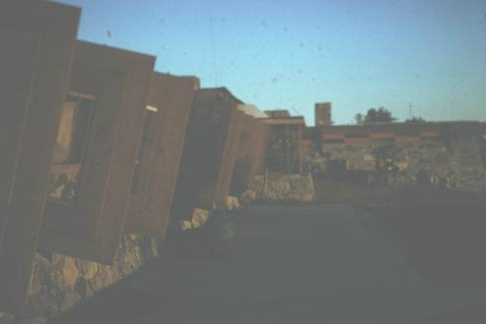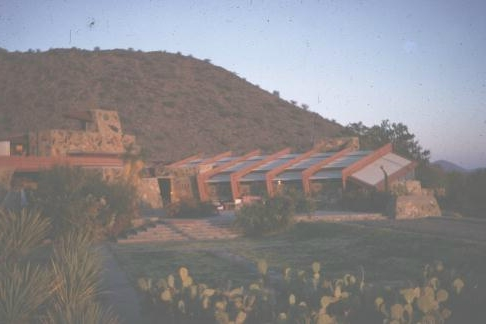
| Frank Lloyd Wright |
Robert Green AIA |
|
TALIESIN WEST (pronounced Tal-e-essin) |
|
And Frank Lloyd Wright had an astounding `feel' for the landscape, an unparalleled sense of the type of structure which would fit and not do damage to the beauty of the desert, a building that, in fact, would seem as if it had taken root and grown up there along with the cactus.

Frank Lloyd Wright further said, "I was struck by the beauty of the desert, by the dry, clear sun-drenched air, by the stark geometry of the mountains--the entire region was an inspiration in strong contrast to the lush, pastoral landscape of my native Wisconsin. And out of that experience, a revelation is what I guess you might call it, came the design for these buildings. The design sprang out of itself, with no precedent and nothing following it."

About Frank Lloyd Wright's Taliesin West McCarter says, "As it was built and originally inhabited, every room in the house was open on at least one side to the desert... All manner of rolling, hinged, stretched and loose canvas allowed an enormous range of adaptability to the daily changes of climate typical in the desert, and created a house where almost every space was simultaneously inside and outside. The canvas roofs, with their wood-framed, canvas-covered flaps at the eaves and gables for ventilation, dominate our experience of the house. The light, coming largely from above, is extraordinary; Wright said, `I found the white luminous canvas overhead and canvas flaps used instead of window glass afforded such agreeable diffusion of light within, was so enjoyable and sympathetic to the desert, that I now felt more than ever oppressed by the thought of the opaque solid overhead of the much too heavy Midwestern houses.'"
McCarter continues, "The original construction of Taliesin West was intended to be both permanent--the stone foundations `excavated' from the site--and cyclical or seasonal--involving replacement of the canvas roofs and flaps as part of the Fellowship's annual `migration' from Wisconsin to Taliesin. In considering the changes and additions that Wright himself made late in his life and those the Fellowship group has made since Frank Lloyd Wright's death, we should remember that Taliesin West was built by Mr. Wright--and used as long as he lived--as a